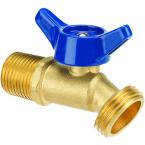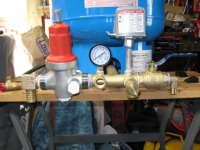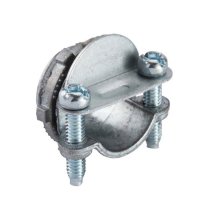A 36 gallon tank only holds 8 gallons of water. Cycling the pump for every 8 gallons used is lots of cycling.
You are using an out of date browser. It may not display this or other websites correctly.
You should upgrade or use an alternative browser.
You should upgrade or use an alternative browser.
Well water occasionally shuts off for a few seconds
- Thread starter DYI13
- Start date
Users who are viewing this thread
Total: 2 (members: 0, guests: 2)
Sarg
Enjoy Learning
A ball valve hose bib is the best choice for your T-Pipe tank connection. The compression valves usually develop a leak ... part of Murphies Law.
I'll mention I went through a similar situation with my system a couple months ago. I also decided to rework the entire system and replace everything.
Pressure tank , T- connector , switch , gauge , other fittings ( and water heater )
When disassembling my old system I realized my old pressure tank had a ruptured bladder, the switch nipple was about plugged closed and the heater was about rusted through the bottom.
I notice in your pictures there is a check valve at your tank. I removed mine after learning it was not a good idea to have two check valves. ( replaced it with a CSV as shown in my earlier posted picture as recommended by Mr. Austin a.k.a. valveman )
After the new system was up and running I also realized the check valve at my 28 year old pump was leaking down ( pump worked fine but the check valve leaked ) causing my system to cycle every thirty minutes .... so I had the pump replaced also.
A little expensive but the peace of mind was worth it all.
I'll mention I went through a similar situation with my system a couple months ago. I also decided to rework the entire system and replace everything.
Pressure tank , T- connector , switch , gauge , other fittings ( and water heater )
When disassembling my old system I realized my old pressure tank had a ruptured bladder, the switch nipple was about plugged closed and the heater was about rusted through the bottom.
I notice in your pictures there is a check valve at your tank. I removed mine after learning it was not a good idea to have two check valves. ( replaced it with a CSV as shown in my earlier posted picture as recommended by Mr. Austin a.k.a. valveman )
After the new system was up and running I also realized the check valve at my 28 year old pump was leaking down ( pump worked fine but the check valve leaked ) causing my system to cycle every thirty minutes .... so I had the pump replaced also.
A little expensive but the peace of mind was worth it all.
Attachments
Last edited:
Sponsor
Paid Advertisement
DYI13
Member
Are you saying that when this tank goes, I should purchase a larger tank? I have a 4 bedroom, 2 1/2 bath house.A 36 gallon tank only holds 8 gallons of water. Cycling the pump for every 8 gallons used is lots of cycling.
Sarg
Enjoy Learning
I'll also mention I had experienced the same erratic pressure fluctuations in my old system and I now think they were generated by a combo of the faulty pressure tank and clogged switch nipple. I realized there was water in the top portion of the bladder that I could hear sloshing around when I shook it. Otherwise I would not have known the bladder leaked because there was no physical symptoms ( Tank held pressure and no water emitted from the schrader valve ) other than the "erratic" operation with no consistency.
Last edited:
Bannerman
Well-Known Member
Home size has no bearing on the size of pressure tank needed. The water comes from the well. The pressure tank is only needed to reduce pump cycling.
The appropriate size tank will cause the pump to operate for 60-120 seconds to raise the system pressure from the cut-in pressure to the cut-out pressure such as 40/60 psi.
The CSV mentioned will eliminate cycling as it will cause your exsisting pump to deliver only the specific quantity of water being used. Once the pump is operating, the flow will be regulated to one constant pressure for as long as water continues to be utilized. A large pressure tank will be no longer required and a 4.4 gallon pressure tank will be suitable for most residential applications.
The appropriate size tank will cause the pump to operate for 60-120 seconds to raise the system pressure from the cut-in pressure to the cut-out pressure such as 40/60 psi.
The CSV mentioned will eliminate cycling as it will cause your exsisting pump to deliver only the specific quantity of water being used. Once the pump is operating, the flow will be regulated to one constant pressure for as long as water continues to be utilized. A large pressure tank will be no longer required and a 4.4 gallon pressure tank will be suitable for most residential applications.
What Bannerman and Sarg said. Without a CSV you want as large a tank or tank(s) as you can get to reduce the cycling. But the larger tank(s) will only reduce the cycling, not eliminate like a CSV will do. Plus, the large tank only system will cause your pressure to go up and down from 40 to 60 as the tank fills and empties.
Sarg
Enjoy Learning
Are you saying that when this tank goes, I should purchase a larger tank? I have a 4 bedroom, 2 1/2 bath house.
Bet a dollar valveman will suggest replacing the check valve with a CSV1A . Go to cyclestopvalves and start reading up.
EDIT = "I WIN"
I am nothing if not predicable.Bet a dollar valveman will suggest replacing the check valve with a CSV1A . Go to cyclestopvalves and start reading up.
EDIT = "I WIN"
I had missed that.I notice in your pictures there is a check valve at your tank. I removed mine after learning it was not a good idea to have two check valves.
Note two check valves are good if one is in the pump, and the other is just above the pump. It's the above-water check valves that cause the negative stuff.
Bannerman
Well-Known Member
How easy is it to be right when 'predicting' something that had already occured.Bet a dollar valveman will suggest ... EDIT = "I WIN"
Sarg
Enjoy Learning
How easy is it to be right when 'predicting' something that had already occured.
But I was typing while the others were posting ........... I'm slow on the keyboard and I had to scratch the pup..
Attachments
LLigetfa
DIYer, not in the trades
Is it galvanized? I would use brass.I went with the 3" nipple
DYI13
Member
Hmm, I'm just seeing this post about a CSV now. Might be more than I can understand or handle as a weekend plumber. I am good about replacing what is already there--not so good about adding something new. Never did anything with the pressure tank before, so this will be my first adventure.Bet a dollar valveman will suggest replacing the check valve with a CSV1A . Go to cyclestopvalves and start reading up.
EDIT = "I WIN"
I plan to use grey sealing paste versus teflon tape in all but the 1/4 " fittings and really make sure they are tight (hope that's right).
I think you are saying that my system has 2 check valves. Under all of that corrosion, I only see one. Can you point to which photo shows it? Thanks.
You will have one at/in the submersible pump, so that will not be in a photo.I think you are saying that my system has 2 check valves. Under all of that corrosion, I only see one. Can you point to which photo shows it?
Sarg
Enjoy Learning
Can you point to which photo shows it? Thanks.
Image 2712 #22 ... to the right of the switch & relief valve.
Almost identical to my original set up before I replaced it all.
Attachments
DYI13
Member
My husband the engineer is sold on the concept of this. I guess it is especially useful if a lot of water is used at one time. I would put it in the line in place of the check valve? What specs about my existing system do I need to set it properly? The csv1 is the right one to purchase? One glitch— our whole house filter (5 micron) gets really dirty, we change every 6 weeks. Will this present a problem? Thanks!Home size has no bearing on the size of pressure tank needed. The water comes from the well. The pressure tank is only needed to reduce pump cycling.
The appropriate size tank will cause the pump to operate for 60-120 seconds to raise the system pressure from the cut-in pressure to the cut-out pressure such as 40/60 psi.
The CSV mentioned will eliminate cycling as it will cause your exsisting pump to deliver only the specific quantity of water being used. Once the pump is operating, the flow will be regulated to one constant pressure for as long as water continues to be utilized. A large pressure tank will be no longer required and a 4.4 gallon pressure tank will be suitable for most residential applications.
Last edited:
If your 36 gallon size tank is still good, you can add a CSV1A and put it in the place where you take out the check valve. Set at 55 PSI using that size tank and a 40/60 switch would deliver 55 PSI constant to the house. If the tank needs replacing you can do so with a 4.5 gallon size tank. The dirt in the system won't effect the CSV1A except tp wear it out in maybe 10-15 years instead of 25-30 years. Using the CSV1A to eliminate the cycling will also keep from surging the well up and down, which may help keep from stirring the dirt up in the first place.
Sarg
Enjoy Learning
DYI13
Member
My switch is 30/50–that’s what the pressure tank is used to all these years, so I should set the csv at 45?If your 36 gallon size tank is still good, you can add a CSV1A and put it in the place where you take out the check valve. Set at 55 PSI using that size tank and a 40/60 switch would deliver 55 PSI constant to the house. If the tank needs replacing you can do so with a 4.5 gallon size tank. The dirt in the system won't effect the CSV1A except tp wear it out in maybe 10-15 years instead of 25-30 years. Using the CSV1A to eliminate the cycling will also keep from surging the well up and down, which may help keep from stirring the dirt up in the first place.
I put it in conduit later. Just trying to keep the video short as possible. As an old well driller I can do the plumbing and wiring, but making it into a video is a challenge. 
Yes.
My switch is 30/50–that’s what the pressure tank is used to all these years, so I should set the csv at 45?
Yes.
Similar threads
- Replies
- 10
- Views
- 667
- Replies
- 23
- Views
- 750
- Replies
- 2
- Views
- 273
- Replies
- 7
- Views
- 398
- Replies
- 11
- Views
- 773




